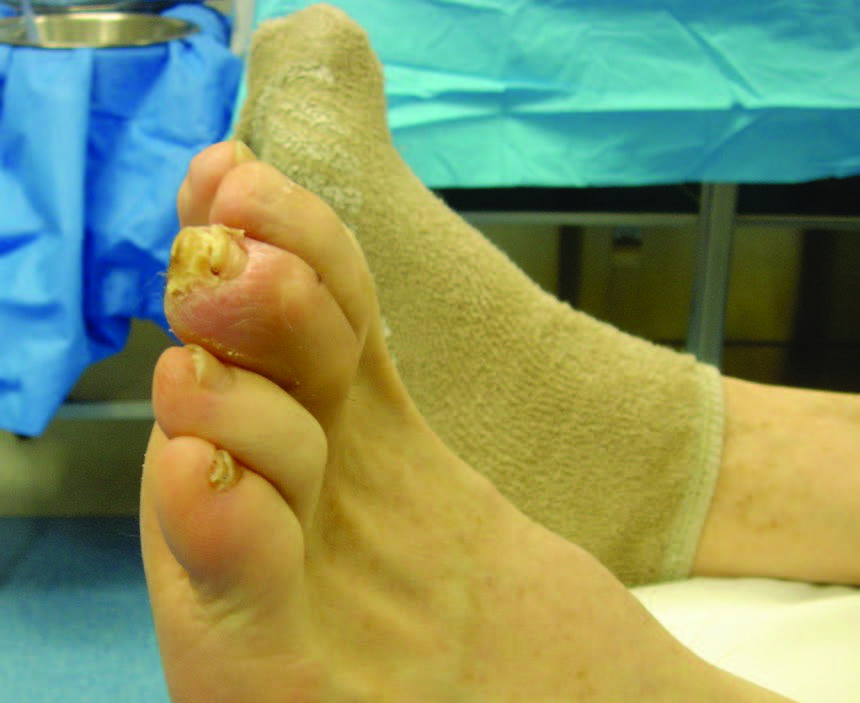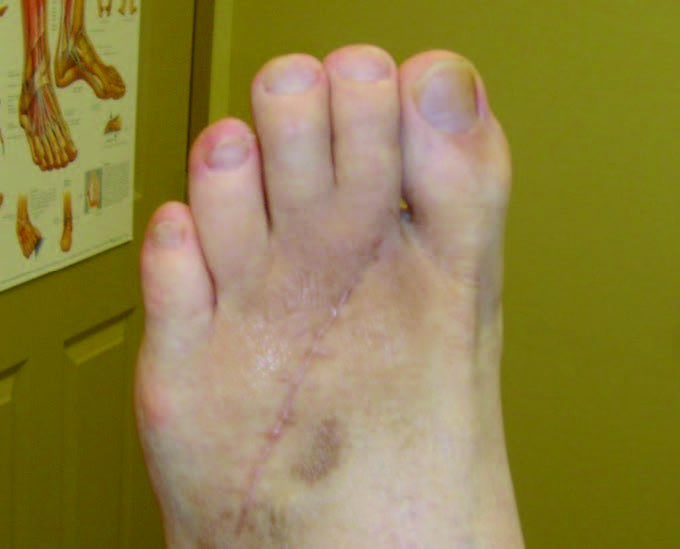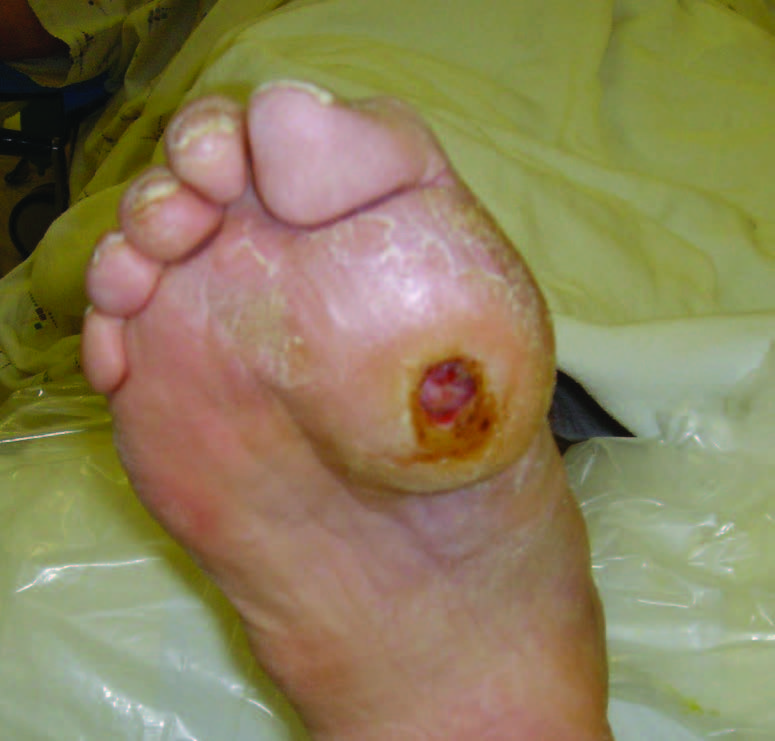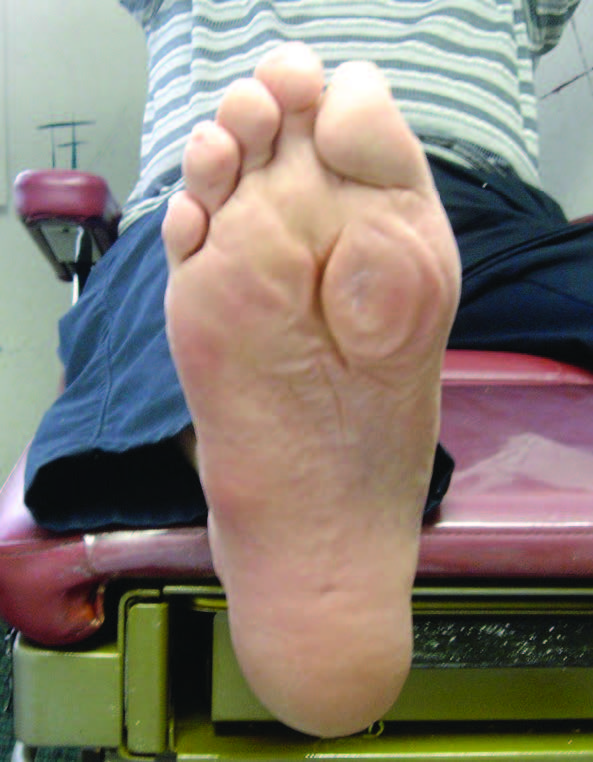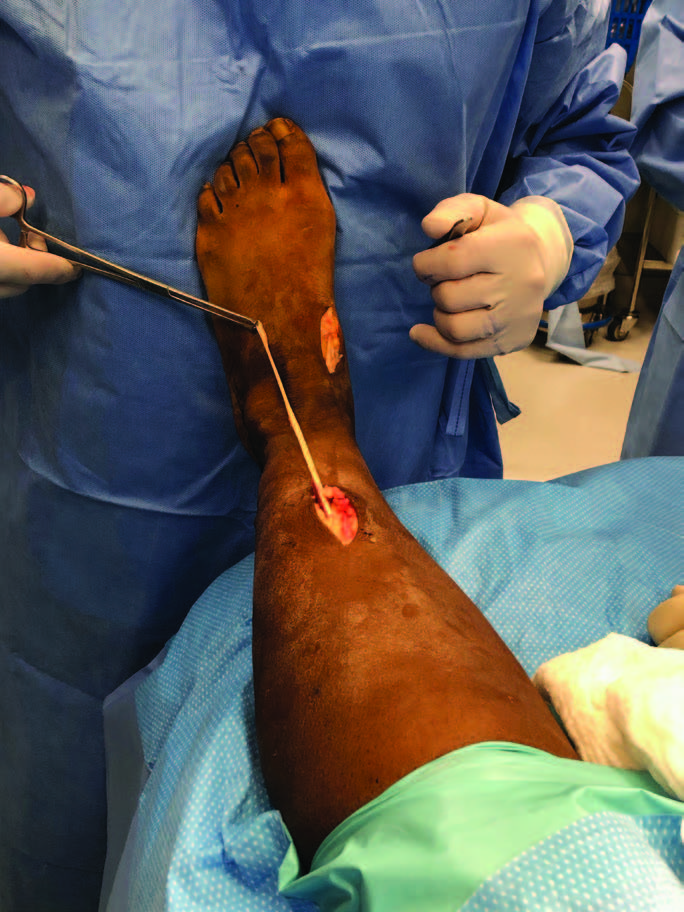ADVERTISEMENT
A Closer Look At Tendon Transfers For Non-Healing Wounds
Offering insights on underlying pathology, tips on technique and compelling case study examples, these authors say tendon transfer procedures may be beneficial in addressing musculotendinous imbal-ances, salvaging bone and tissue, and preventing ulcer recurrence.
Non-healing wounds of the foot and ankle commonly result from neuropathy and imbalanced biomechanical forces in the lower extremity. These wounds frequently occur in patients with diabetes. A lack of sensation over an increased area of pressure may lead to extended microtrauma, tissue breakdown and an eventual ulceration or wound. With this in mind, let us take a closer look at the role tendon transfers may play in treating underlying pathology and facilitating complete healing.
Pressure imbalances within the foot, ankle and lower extremity in the neuropathic population increase the risk for wound formation. Soft tissue structures, particularly tendons, have a powerful effect in altering the mechanics of the foot and ankle. Tendinous structures can gain a mechanical advantage and exacerbate pressure on bony structures. In many instances, there is no bone associated with the direct cause of the wound, but instead, increased pressure on the bone causes the wound. In the neuropathic foot and ankle, the resultant repetitive trauma and buildup of hyperkeratotic tissue subsequently increase the risk for developing wounds.1
Neutralization and release or transfer of these tendinous structures allow for reduction of force to these pressure areas. The transfer of tendons can rebalance the pressures of the foot and serve as a tool for surgical offloading. In the forefoot, performing a tendon transfer can often offload pressure and correct deformity without the need for osseous procedures in the lesser digits and metatarsals. More proximally in the foot, surgeons may perform tendon transfers to rebalance and alter plantar pressures not only distally but in the midfoot as well. Tendon transfers allow for pressure changes in multiple planes of a deformity and one can also combine these procedures with osseous procedures when necessary to augment offloading.2
We subscribe to the philosophy of attempting to leave remaining bone alone when possible to prevent the loss of cubic volume, preventing instability and thus maintaining stability about the anatomical site.
Key Concepts With Forefoot Tendon Transfers And Hammertoe Correction
Hammertoes are a common forefoot deformity caused by muscle/tendon imbalance. A flexion contracture occurs at the proximal interphalangeal joint (PIPJ) and subsequently can cause hyperextension at the MPJ.3 These deformities place the patient at risk for wound formation dorsally at the PIPJ, distally at the distal interphalangeal joint and at the tip of the digit. Retrograde forces of the digital contracture can cause increased plantar pressures at the metatarsal heads. Common elective forefoot procedures can help facilitate surgical offloading of these wounds.
While there is a number of established hammertoe procedures recognized in the literature, in our experience, we have found tendon transfers and balancing the foot to be the most effective approach in the correction of hammertoe deformity. This enables surgeons to address the underlying pathology, remove the deforming force and prevent reoccurrence.
In a meta-analysis, Jules, Trepal and colleagues noted a 91.8 percent patient satisfaction rate following a flexor tendon transfer for elective hammertoe correction.4 Tendon transfers allows neutralization of deforming forces and anatomical reduction without loss of cubic volume of bone. The transfer also helps maintain the corrected position while allowing functional toe purchase.2
Contracture of the MPJ is common with hammertoe deformity. The plantar plate is an important structure in stabilizing the lesser MPJs.5-7 Repetitive trauma causes attenuation of the plantar plate static structures, leading to destabilization at the level of the joint.8 Further weakening and tear of the plantar plate leads to contracture at the joint level, causing increased pressure under the metatarsal head, making this a common area for wound formation at higher risk for amputation sequelae.9,10
Extensor digitorum longus to extensor digitorum brevis tendon transfers (a modification of the Hibbs procedure) allow indirect stabilization across the MPJ via reduction of the extensor tendon deforming forces. One often combines this procedure with a complete capsulotomy release of the joint contracture and a modified Hibbs transfer. As is the case with our aforementioned hammertoe correction, soft tissue augmentation alone allows for neutralization and stabilization of deforming forces without the need for osseous procedures. This approach also enables surgeons to maintain anatomical cubic volume of bone and length. One should note that these forefoot procedures commonly occur in conjunction with a stable first ray procedure when indicated and posterior muscle group lengthening when the patient has an equinus contracture.11-13
Pertinent Pearls With The Flexor Digitorum Longus Tendon Transfer
In regard to the flexor digitorum longus tendon transfer, the surgeon should make an approximately two cm, full-thickness direct medial incision along the toe and identify the flexor digitorum longus tendon without the need for undermining. Then one detaches the flexor digitorum longus tendon at the most distal aspect of the incision, freeing the tendon medially to the proximal aspect of the incision and temporarily clamping it with an Allis clamp to preserve the integrity of the tendon.
Proceed to sharply release the attachments of the flexor digitorum brevis ten-don at the base of the intermediate phalanx (both the medial and lateral insertions of the flexor digitorum brevis) and make a plantar capsulotomy at the level of the PIPJ and/or distal interphalangeal joint (DIPJ) (if a flexion contracture is present at the DIPJ). One can then reduce and extend the toe with manual reduction to allow release of any residual contracted structures in the PIPJ and/or DIPJ respectively. This allows the surgeon to place the toe in a rectus position and insert an 0.062 inch K-wire to stabilize the toe in a more anatomic position. With the toe in this corrected, stabilized position, one can then attach the flexor digitorum longus tendon to the extensor hood through the same incision under physiological tension. Surgeons can perform skin closure with their suture of choice but should pay careful attention to avoid the neurovascular structures.
What You Should Know About Performing The Extensor Digitorum Longus Tendon To Extensor Digitorum Brevis Tendon Transfer
The first step for this procedure is making a full-thickness oblique incision from the head of the second metatarsal to the base of the fourth metatarsal. Then using a feathering technique into the subcutaneous tissue, one can expose both the extensor digitorum longus tendons and extensor digitorum brevis tendons in a linear fashion along the course of these tendons. This will allow the surgeon to avoid disruption to the neurovascular structures. Employing a curved hemostat, the surgeon can subsequently expose and free the extensor digitorum longus tendon most proximally within the surgical wound and free the extensor digitorum brevis tendon most distally within the incision. The surgeon then cuts the extensor digitorum longus tendon at the most proximal portion of the incision. One would proceed to clamp the most proximal stump with a hemostat and the distal stump with an Allis clamp. The surgeon then cuts the extensor digitorum brevis tendon at the most distal aspect of the incision and clamps it with an Allis clamp.
At this time, the surgeon performs a complete capsulotomy at the MPJ followed by release of the plantar structures with a McGlamry elevator. Release of the contracture allows for reduction of the MPJ into a neutral position. Repeat as necessary to the other metatarsophalangeal joints. One would typically perform this release in combination with the flexor digitorum longus tendon transfer as we stated above. Once the surgeon has obtained the optimal position as we described earlier, he or she places K-wires across the distal interphalangeal joints, the proximal interphalangeal joints and the MPJ, and into the base of the metatarsal for stabilization.
The surgeon should then direct attention back to the most proximal portion of the distal stump of the extensor digitorum longus tendon. One makes a stab incision within the proximal aspect of the remaining distal extensor digitorum longus tendon, which is the portion that inserts into the toes. By inserting a vasectomy clamp within the proximal portion of the remaining extensor digitorum longus tendon, the surgeon can then obtain the extensor digitorum brevis distal portion of the proximal stump and weave it into the remaining distal extensor digitorum longus tendon.14
This weave graft provides stability for a tenodesis that one can secure with poliglecaprone 25, (Monocryl®, Johnson & Johnson). Prior to this, the surgeon should employ K-wires to secure the position of the weave graft to allow for physiological tension of the tenodesis.
Then one reroutes the proximal stumps of the previously cut second, third and fourth extensor digitorum longus tendons under the neurovascular structures, tenodesing and suturing into the peroneus tertius or the periosteum of the midfoot with the ankle held at 90 degrees and the tendons under physiologic tension. This will aid the patient with ankle joint dorsiflexion. Patients who have this pathology consisting of extensor substitution/ recruitment commonly suffer from this biomechanical tendon imbalance, which in turn leads to the deformity. After closing subcutaneous tissue, the surgeon can proceed to close the skin.
In one applicable case, a patient had hammertoe deformities of the lesser digits of the left foot and a pressure ulcer of the third toe (see first photo above). The flexion contracture was the underlying etiology to the hammertoes, resulting in increased pressure to the distal tip of the third digit. A bone biopsy revealed osteomyelitis. This patient suffered from a combination of extensor recruitment/ substitution and flexion contracture of the proximal and distal interphalangeal joints. After a six-week course of intravenous antibiotics and distal bone debridement of the distal phalanx, we performed tendon transfers of the second through fifth digits on the left foot.
Following the removal of K-wire fixation of the lesser toes, post-op radiographs and clinical examination revealed no loss of cubic volume of bone or instability of the MPJ or interphalangeal joints. This patient exhibited postoperative toe purchase to the ground in anatomic alignment and the permanent removal of the deforming force prevented the ulcer from reoccurring. This surgical reconstruction took place approximately 13 years ago and there has been no reoccurrence (see second photo above).
Essential Aspects Of The Peroneus Longus Tendon To Peroneus Brevis Tendon Transfer
A primary function of the peroneus longus muscle is to plantarflex the first metatarsal. When overdrive of the peroneus longus occurs, excessive pull by the tendon produces a plantarflexed deformity within the first metatarsal.2 This deformity can eventually lead to ulceration underneath the first metatarsal head due to increased plantar pressure.
In regard to an accurate clinical diagnosis, one can apply one thumb underneath the first metatarsal head and the other thumb across the remaining metatarsal heads. Then ask the patient to plantarflex his or her foot toward your thumbs. With peroneus longus overdrive, you will feel more force underneath the first metatarsal head in comparison to the lesser metatarsal heads.15 Essentially, the peroneus longus will plantarflex the first metatarsal head down, considerably out of line from the lesser metatarsals. Overactivity within the peroneus longus muscle is possibly to compensate for a weak gastrocsoleus complex with plantarflexion. Transferring of the peroneus longus tendon to the peroneus brevis tendon allows for the peroneus longus to continue to evert the foot but prevents independent, excessive plantar-flexion of the first metatarsal.2
In order to perform this tendon transfer, one should direct attention to the lateral aspect of the foot overlying the cuboid where the peroneal tendons are located. Making an approximately four cm incision, the surgeon carries the incision deep within the same plane, avoiding the sural nerve. At this point, both the peroneus longus and brevis tendons are exposed and isolated. Transect the peroneus longus tendon at its most distal aspect. One should then transect the proximal stump of the peroneus longus tendon as far distal and plantar as possible within the incision site. The surgeon subsequently transfers the proximal stump of the peroneus longus tendon into the peroneus brevis tendon through a “weave graft technique” under physiologic tension and then performs skin closure.16 The remaining peroneus longus tendon has many attachments at the first tarsometatarsal joint that assist in maintaining stability at this site.
In one case involving this type of tendon transfer, a patient demonstrated a forefoot ulcer under the first metatarsal head secondary to peroneus longus overdrive (see left photo above). In this particular case, the peroneus longus overdrive was secondary to Charcot-Marie-Tooth disease. We performed a peroneus longus to peroneus brevis tendon transfer in the aforementioned manner. Postoperatively, the patient healed without incident and the procedure permanently removed the pressure from the site (see fourth photo above).
Current Considerations With The Split Anterior Tibialis Tendon Transfer
As we previously stated, altered mechanics of the foot leading to deformity can increase pressure on bony structures, eventually leading to ulceration. The most common lower extremity deformity following a traumatic brain injury is equinovarus deformity of the foot.17 Often, patients will present with a wound on the lateral aspect of the foot secondary to malposition and increased pressure. The split anterior tibialis tendon transfer is a common procedure surgeons employ to treat equinovarus foot deformity in adult hemiplegic patients.
To address the equinus aspect of the deformity, the surgeon should first direct attention toward lengthening the triceps surae. If ankle equinus is present with the knee in both flexion and extension, a Z-lengthening of the calcaneal tendon is required. However, if ankle equinus is only present with the knee in extension, a gastrocnemius recession is the optimal choice.
The next step of the procedure is the split anterior tibialis tendon transfer. After making a two cm incision at the level of the navicular bone at the distal insertion of the anterior tibialis tendon, proceed to make an incision within the anterior tibialis tendon and insert umbilical tape within the tendon.
One subsequently makes an incision at the muscle-tendon junction of the ante-rior tibial tendon, pulling the umbilical tape from distal to proximal and splitting the tendon up to the musculotendinous junction of the anterior tibial tendon. The surgeon then releases the lateral half of the tibialis anterior tendon from its bony insertion and pulls it out of the proximal incision site from distal to proximal with umbilical forceps. He or she then makes another incision at the dorsal lateral aspect of the foot. The surgeon must reduce the deformity and measure the new insertion location. Now one makes an approximate two cm incision down to the periosteum. Next, one inserts the umbilical forceps in the distal lateral incision site of the lower leg to obtain the lateral half of the anterior tibial tendon. The surgeon then reduces the foot and ankle into a neutral position and transfers the lateral half of the anterior tibial tendon to insert into
the dorsal lateral aspect of the midfoot under physiologic tension. This reduces the varus deformity.
The surgeon may use his or her choice of anchor for the insertion of the transferred tendon to its new insertion site. One can use many options such as suturing to the periosteum, using a suture anchor or an interference screw. The senior author prefers an interference screw for adequate tensioning. It is important for one to hold the foot in a neutral position in the frontal plane during fixation to prevent resting varus and adjust the tendon transfer tension. The surgeon subsequently closes the three incision sites.18
Another consideration is whether to transfer the tendon under or over the extensor retinaculum. There are advantages and disadvantage of both approaches that are beyond the scope of this discussion.
Addressing equinus is an important component when offloading any increased plantar pressures in the foot. Gastrocnemius equinus is the most common cause of abnormal pronation, which one can easily alleviate through a gastrocnemius recession.2 As we stated earlier, a Z-lengthening of the Achilles tendon may be required depending on the involvement of the muscles of the triceps surae. Correcting for equinus will allow for a more even distribution of pressure on the foot, which will help eliminate the risk of neuropathic pressure ulcers and hyperkeratotic lesions
In Conclusion
Chronic mechanical dysfunction of the foot can lead to extensive foot deformity. In certain patient demographics, particularly patients with neuropathy and diabetes, the deformities can progress to severe ulcerations and lead to increased risk of morbidity and mortality. Through utilizing surgical techniques such as tendon transfers, the podiatric surgeon can correct and compensate for these mechanical abnormalities, providing the patient with a better quality of life and a decreased likelihood of ulcerations.
Dr. Ley is a Fellow of the Reconstructive Foot and Ankle Surgical Fellowship with NOMS Ankle and Foot Care Centers in Youngstown, Ohio.
Dr. Sadeghi is a second-year podiatric surgery resident at East Liverpool City Hospital in East Liverpool, Ohio.
Dr. DiDomenico is the Director of Fellowship Training for the Reconstructive Foot and Ankle Surgical Fellowship at NOMS Ankle and Foot Care Centers in Youngstown, Ohio. He is the Director of Residency Training at East Liverpool City Hospital in East Liverpool, Ohio. Dr. DiDomenico is a Fellow of the American College of Foot and Ankle Surgeons.
1. Fernando ME, Crowther RG, Lazzarini PA, et al. Plantar pressures are higher in cases with diabetic foot ulcers compared to controls despite a longer stance phase duration. BMC Endocr Disord. 2016;16(1):51.
2. Hansen ST. Functional reconstruction of the foot and ankle. Philadelphia:Lippincott Williams & Wilkins;2000:415-462.
3. Butterworth M. Tendon transfers for management of digital and lesser metatarsophalangeal joint deformities. Clin Pod Med Surg. 2016;33(1):71-84.
4. Losa Iglesias ME, de Bengoa Vallej RB, Jules KT, Trepal MJ. Meta-analysis of flexor tendon transfer for the correction of lesser toe deformities. J Am Podiatr Med Assoc. 2012;102(5):359-368.
5. Yu GV, Judge M. Predislocation syndrome of the lesser metatarsophalangeal joint: a distinct clinical entity. Reconstructive Surgery of the Foot and Leg. Podiatry Institute. Available at: http://www.podiatryinstitute.com/pdfs/Update_1995/1995_20.pdf . Published 1995. Accessed July 8, 2020.
6. Bhatia D, Myerson MS, Curtis MJ, Cunningham BW, Jinnah RH. Anatomical restraints to dislocation of the second metatarsophalangeal joint and assessment of a repair technique. J Bone Joint Surg Am. 1994;76(9):1371-1375.
7. Fortin PT, Myerson MS. Second metatarsophalangeal joint instability. Foot Ankle Int. 1995;16(5):306-313.
8. Yu GV, Judge MS, Hudson JR, Seidelmann FE. Predislocation syndrome: progressive subluxation/dislocation of the lesser metatarsophalangeal joint. J Am Podiatr Med Assoc. 2002;92(4):182-199.
9. Moulik PK, Mtonga R, Gill GV. Amputation and mortality in new-onset diabetic foot ulcers stratified by etiology. Diabetes Care.2003;26(2):491-494.
10. Bild DE, Selby JV, Sinnock P, Browner WS, Braveman P, Showstack JA. Lower extremity amputation in people with diabetes: epidemiology and prevention. Diabetes Care. 1989;12(1):24-31.
11. DiGiovanni CW, Kuo R, Tejwani N, et al. Isolated gastrocnemius tightness. J Bone Joint Surg. 2002;84(6):962-970.
12. Armstrong DG, Stacpoole-Shea S, Nguyen H, Harkless LB. Lengthening of the Achilles tendon in diabetic patients who are at high risk for ulceration of the foot. J Bone Joint Surg. 1999;81(4):535-538.
13. Mueller MJ, Sinacore DR, Hastings MK, Strube MJ, Johnson JE. Effect of Achilles tendon lengthening on neuropathic plantar ulcers: a randomized clinical trial. J Bone Joint Surg. 2003;85(8):1436-1445.
14. DiDomenico LA, Luckino FA, Butto, DN. Tendon transfers for digital deformities and hammertoes. In: Cook EA, Cook JJ, eds. Hammertoes: A Case-Based Approach. New York: Springer; 2019: 209-239.
15. Desai SN, Grierson R, Manoli A. The cavus foot in athletes: fundamentals of examination and treatment. Op Tech Sports Med. 2010;18(1):27- 33.
16. DiDomenico LA, Abdel Fattah SR, Hassan MK. Emerging concepts with tendon transfers. Podiatry Today. 2018;31(2):26-32.
17. Hosalkar H, Goebel J, Reddy S, Pandya NK, Keenan MA. Fixation techniques for split anterior tibialis transfer in spastic equinovarus feet. Clin Orthop Rel Res. 2008;466(10):2500-2506.
18. Gasse N, Luth T, Loisel F, et al. Fixation of split anterior tibialis tendon transfer by anchorage to the base of the 5th metatarsal bone. Orthop Traum Surg Res. 2012;98(7):829-833.






